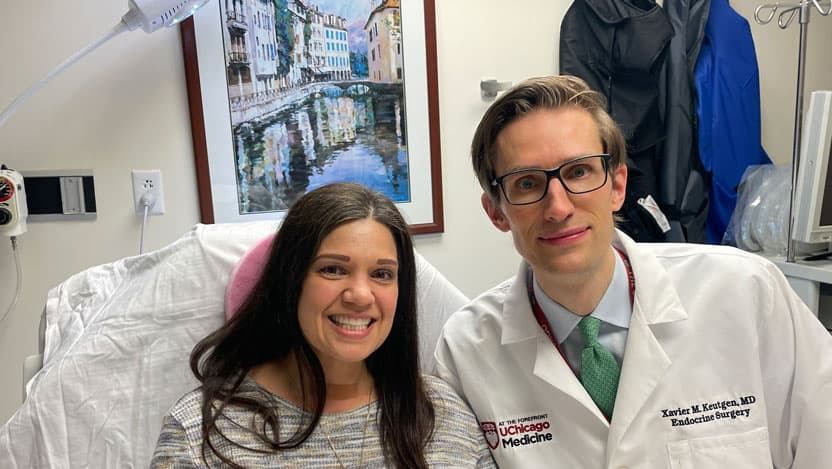UChicago Medicine harnesses radiofrequency ablation to destroy benign thyroid nodules

Crissy Tsiakopoulos, of Cedar Lake, Indiana, poses with her UChicago Medicine endocrine surgeon Xavier, Keutgen, MD, who treated her thyroid nodules with a new technique called radiofrequency ablation.
Most people don't think twice about the act of swallowing. Whether it's sipping a cup of coffee or eating a sandwich, you probably don't really notice when food or liquid moves from your mouth to your stomach — at least, until a problem arises.
For Crissy Tsiakopoulos, 46, the problem began in December 2019.
"Every time I swallowed, I felt like something was pressing on my throat," said the Cedar Lake, Indiana, resident.
She checked a mirror, saw nothing unusual, but the feeling of compression was clear.
"I had no clue what it was," said Tsiakopoulos. "But I knew it was in my throat."
A nasopharyngoscopy — when an ear, nose and throat physician guides a flexible scope through the nose to examine the throat — revealed nothing. But an ultrasound found a lump on the right side of her thyroid, a hormone-producing gland in the base of the neck.
For Tsiakopoulos, who researched her condition online, it was hard not to assume the worst. No one in her family had the lumps, known as thyroid nodules, and 5% to 15% of the patients with them had cancerous nodules.
Fortunately, a biopsy revealed the nodule was benign.
"Okay, it's noncancerous, that's great, but it's still in my throat and growing," said Tsiakopoulos. "Now what?"
The doctor explained that benign thyroid nodules are common and that many people live without ever noticing them. However, sometimes these nodules induce distinct symptoms and require surgical removal.
"That was the one thing I wanted to avoid," said Tsiakopoulos, who was reluctant to be on long-term thyroid medication, a possibility depending on the type of surgery performed.
So, she tried living with her lump. The nodule shrank after the biopsy needle removed some of the tissue. Still, by May 2022, the pressure was back on her throat and the nodule had grown larger.
On the recommendation of her doctor, she underwent another ultrasound and biopsy to shrink the lump. But Tsiakopoulos sought an additional, longer-lasting solution.
That's when she found an online article about radiofrequency ablation (RFA), a technique where doctors use heat to destroy nodules. The technique has been used in South Korea and Europe for many years.
"Radiofrequency ablation essentially adds a whole new dimension to the treatment of benign thyroid nodules because it allows patients to avoid an operation while shrinking the nodule and resolving the symptoms," said Xavier Keutgen, MD, an endocrine surgeon at University of Chicago Medicine.
Ideally, nodules eligible for RFA are equal or less than 4 centimeters wide and located on one side of the thyroid. A biopsy should also have proven them benign. Patients with larger nodules, bilateral nodules or multiple nodules can also be considered for RFA in certain circumstances.
I thought to myself, if this is a treatment that's going to be brand-new, I want to go to the University of Chicago Medicine.
"I thought to myself, if this is a treatment that's going to be brand-new, I want to go to the University of Chicago Medicine," said Tsiakopoulos.
Tsiakopoulos connected with Keutgen, who was preparing to be one of the first doctors in Chicago to offer RFA as an option for benign thyroid nodules.
"I think the most remarkable thing about Crissy was her willingness to undergo a new procedure and to trust that we would do it well," said Keutgen.
He explained to Tsiakopoulos each step of the procedure — she'd receive a medication to help her relax. A needle would deliver a local anesthetic to numb her neck. He would then insert a special needle (the RFA probe) that destroys thyroid tissue through heat.
Guided by ultrasound, Keutgen would carefully ablate most of the nodule under his direct vision to preserve adjacent tissue.
"We try to destroy anywhere from 70% to 90% of the nodule, but we avoid the part that is close to the recurrent laryngeal nerve and the large blood vessels because we don't want to damage them," said Keutgen.
The areas of the nodule that have been ablated are then reabsorbed by the body.
Tsiakopoulos' procedure in January took about 40 minutes. The next day, she experienced minimal, bruise-related pain.
"Dr. Keutgen called me in the morning to ask how I was doing, and I said, 'I'm perfectly fine,'" said Tsiakopoulos. "I could already feel that the nodule was so much smaller."
She recently had her three-month follow-up and learned that the nodule has shrunk by 70 percent since the ablation. No scar is visible from the procedure.
It's unlikely, but there is a small chance the nodule will regrow. But Tsiakopoulos already has an answer for that.
"Just go and get another RFA, you know?"
